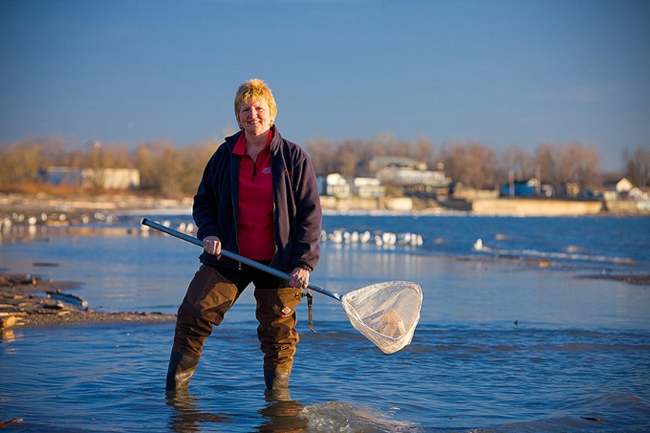
Helen Domske, pictured here at Woodlawn Beach State Park, has spent her career educating the public about issues affecting the world’s oceans and the Great Lakes. Photo: Douglas Levere
University at Buffalo's Michael Andrei profiles New York Sea Grant's Coastal Education Specialist
Buffalo, NY, June 23, 2017 - Helen Domske has never seen a whale shark.
An avid scuba diver, she has been trying for 25 years — most recently in the waters off Cozumel, an island just off Mexico’s Yucatan Peninsula, earlier this month.
“My dive trip to Cozumel was advertised as an opportunity to see whale sharks — in a spot renowned for scuba diving and snorkeling,” Domske says.
“I love diving, and seeing the largest fish in the world up close has become something of a goal of mine.”
Domske, associate director of the Great Lakes Program at UB, has been diving for 37 years. She has done it as a part of a career focused on marine ecology and conservation, preventing water pollution and educating the public about issues affecting the world’s oceans and the Great Lakes, as well as a source of enjoyment.
Domske began diving as curator of education for the Aquarium of Niagara Falls in 1979. In 1993, she became a coastal education specialist for New York Sea Grant, where her work today also entails marine biology. Domske holds an MS from UB and a BS from The College at Brockport. Both degrees are in education.
As associate director of the UB Great Lakes Program, which began as a joint position between UB and Cornell University, she teaches marine ecology, as well as Great Lakes ecology, on the North Campus.
Domske’s career has taken her to many of the world’s best locations for diving: the Galapagos Islands, Australia’s Great Barrier Reef, Hawaii, various spots in the Caribbean and the Baja California peninsula, to name a few. And, most recently, Cozumel.
After diving for years to collect species for the Aquarium of Niagara Falls, Domske has continued to dive in her position with New York Sea Grant.
“For what I am focused on — marine ecology and conservation, preventing water pollution, halting the spread of invasive species — diving is a vital part of how we are able to study underwater ecology,” Domske explains.
“We monitor coral reef health, the effects of pollution on marine life, and document and try to prevent damage that is done by invasive species.”
As she educates the public about issues affecting the Great Lakes, Domske frequently speaks to students, fishermen and boaters about how they can prevent water pollution and help stop the spread of Great Lakes invaders, such as the Asian carp, zebra mussels, quagga mussels and sea lampreys.
“Mussels are small creatures, but they have altered the environment by spreading along the lake bottoms and disrupting the food chain, among other factors,” she says.
“The Great Lakes Program is also focused on the Asian carp, a very aggressive invasive fish that is advancing on Lake Michigan through the Mississippi River. Adult Asian carp have no known adult predators in North America and once they establish themselves in an ecosystem, they are virtually impossible to eradicate.”
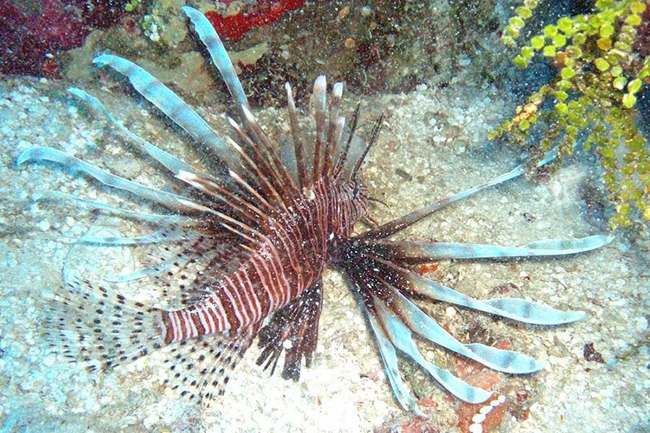
Lionfish, which are not native to the Atlantic and have few predators, kill other fish and are having a terrible effect on the marine environment in the Caribbean, says Helen Domske.
Domske notes the ecological havoc that lionfish have caused in the Caribbean as a case in point.
“Lionfish are native to the Indo-Pacific,” she says. “They were released accidentally by people who bought them … one theory is people began dumping them from home aquariums into the Atlantic. Because they are not native to the Atlantic, they have very few predators there.
“They are a fish that kills other fish,” she says, “including the young of important commercial species such as snapper and grouper, and they are having a terrible impact on the marine environment in the Caribbean. I saw several of them during my dives in Cozumel.”
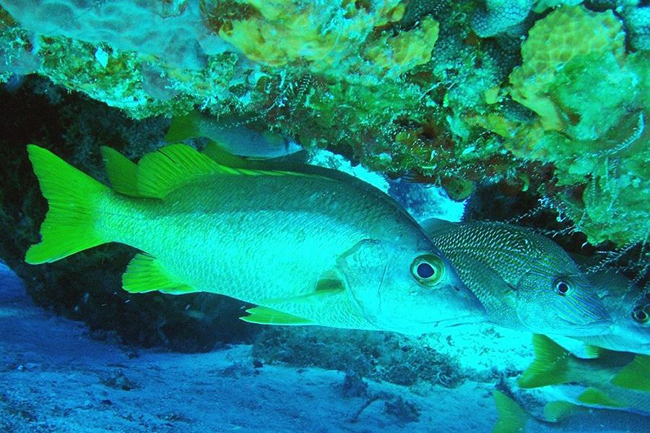
Schoolmaster snapper
Domske says she also dove in a spectacular marine park in the waters surrounding Cozumel.
“Cozumel has a huge tourist base, and diving and snorkeling are a big draw. The marine ecology and the reef there have been protected,” she says.
“The result is a healthy marine environment and a solid tourist economy for the island.”
Domske says during her week there she dove twice daily, in dives of between 60 to 90 feet.
“We were able to dive among a stunning array of marine life,” she says. “Triggerfish, turtles, nurse sharks, rainbow parrotfish, moray eels and lionfish, to name a few.
After spending years diving all over the world, Domske has seen an impressive amount of underwater marine life.
“I have seen 963 different species of fish and marine life — a 24-foot basking shark was memorable, many different types of sea turtles, sea horses and during the time I worked for the aquarium, this included the species you would see during a visit there,” she says.
Which brings Domske back to the whale shark.

One of two resident male whale sharks in the Georgia Aquarium in Atlanta. Photo: Zac Wolf, Wikimedia Commons
Ever since I started, I have been looking for whale sharks, basking sharks and manta rays. I have seen two of the three,” she says.
Basking sharks are the second-largest shark, at 25 feet. Seeing one underwater was impressive, she says. She also feels fortunate to have seen manta rays on a number of dives.
“Despite their size — 40 feet — whale sharks are gentle, they are plankton-eaters,” Domske says. “The entire time I have been diving — 37 years — I have always looked for trips that have the potential to dive with whale sharks.
“About four years ago, I went on a dive trip to the Baja California peninsula, where whale sharks are often seen: Divers there had viewed them three weeks before I arrived, and, as it turned out, again two weeks after I left.
“My dive trip to Cozumel was advertised as an opportunity to see whale sharks in the water,” she says. “But trip organizers can’t guarantee that happening, of course. I love to dive, so there are many more opportunities ahead.
“Diving is something I love. It never gets old, and it is never boring.”
In Photos: Some images taken by Helen Domske on a recent diving trip to Cozumel
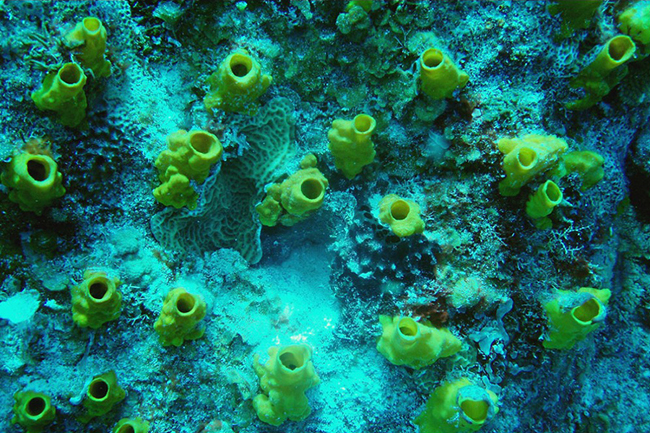
Encrusted sponge
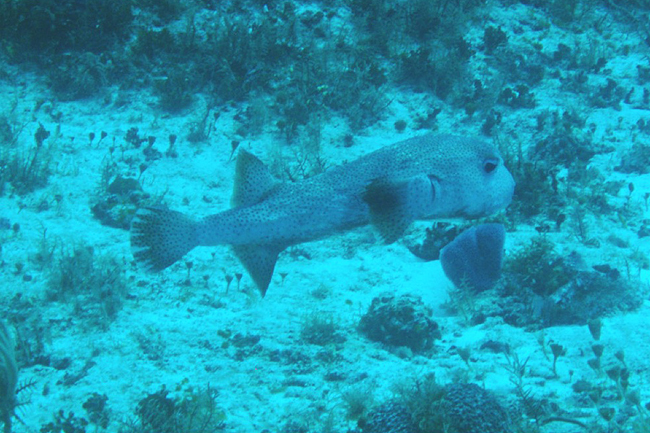
Porcupinefish
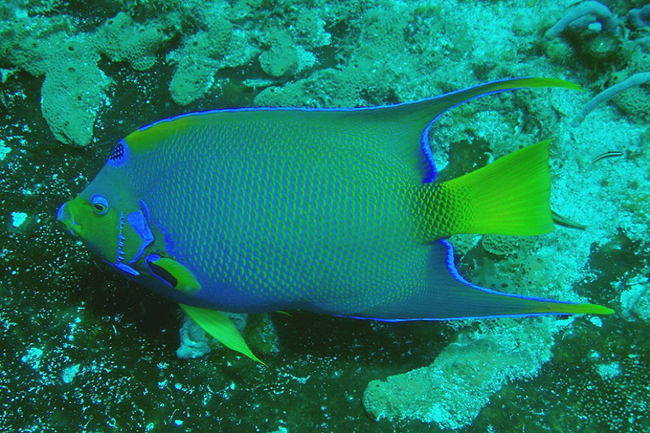
Queen angelfish
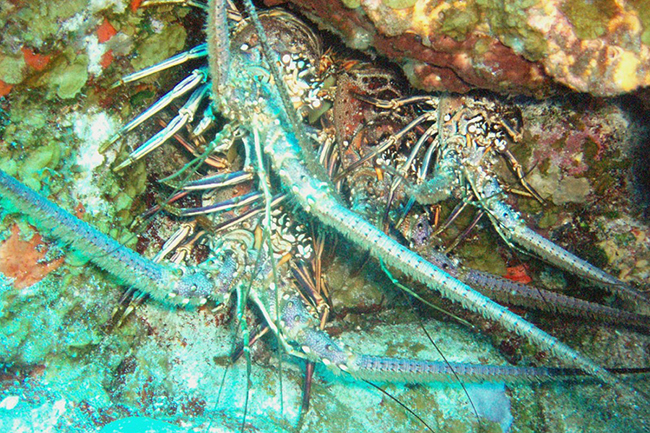
Spiny lobster
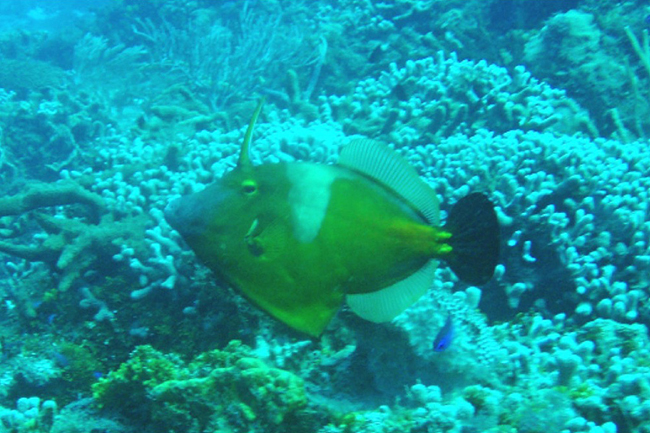
Whitespotted filefish
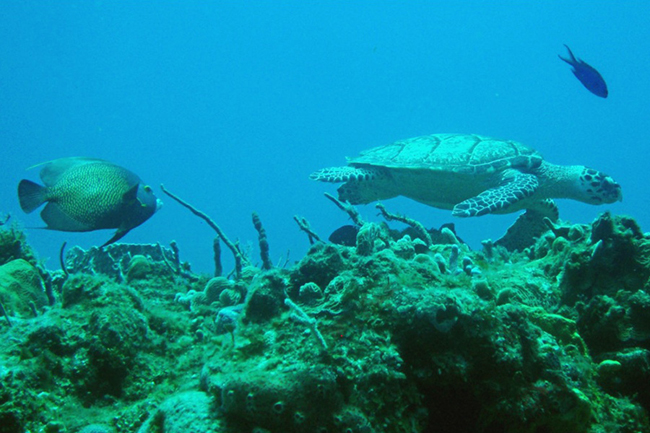
French angelfish and green turtle
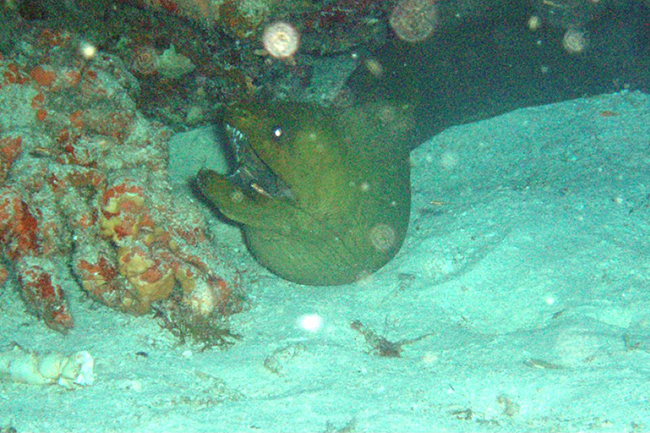
Green moray eel
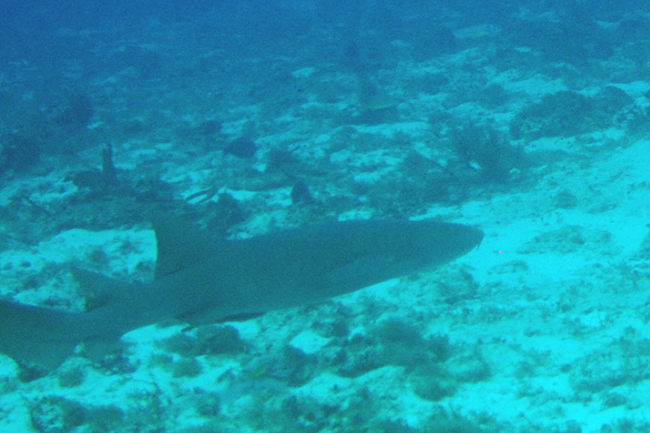
Nurse shark
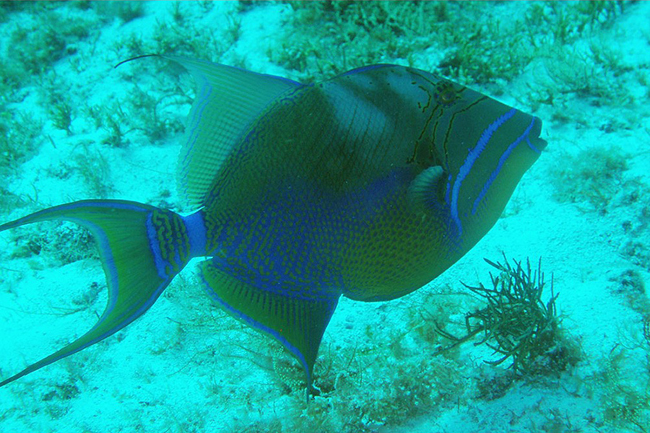
Queen triggerfish
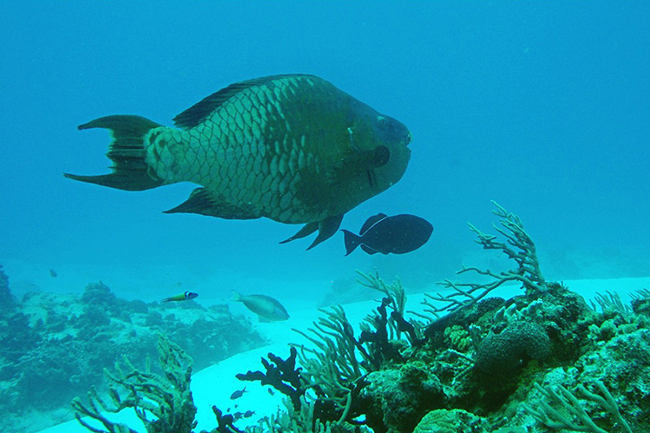
Rainbow parrotfish
More Information:
New York Sea Grant (NYSG), a cooperative program of Cornell University
and the State University of New York, is one of 33 university-based
programs under the National Sea Grant College Program (NSGCP) of the
National Oceanic and Atmospheric Administration (NOAA). The NSGCP
engages this network of the nation’s top universities in conducting
scientific research, education, training and extension projects designed
to foster science-based decisions about the use and conservation of our
aquatic resources. Through its statewide network of integrated
services, NYSG has been promoting coastal vitality, environmental
sustainability, and citizen awareness about the State’s marine and Great
Lakes resources since 1971.
New York Sea Grant maintains Great Lakes offices at SUNY Buffalo, the
Wayne County Cooperative Extension office in Newark and at SUNY Oswego.
In the State's marine waters, NYSG has offices at Stony Brook University
and Stony Brook Manhattan, in the Hudson Valley through Cooperative
Extension in Kingston and at Brooklyn College.
For updates on Sea Grant activities: www.nyseagrant.org has RSS, Facebook, Twitter, and YouTube links. NYSG produces a monthly e-newsletter, "NOAA Sea Grant's Social Media Review," via its blog, www.nyseagrant.org/blog. Our program also offers a free e-list sign up via www.nyseagrant.org/coastlines for its flagship publication, NY Coastlines/Currents, which is published 1-2 times a year.